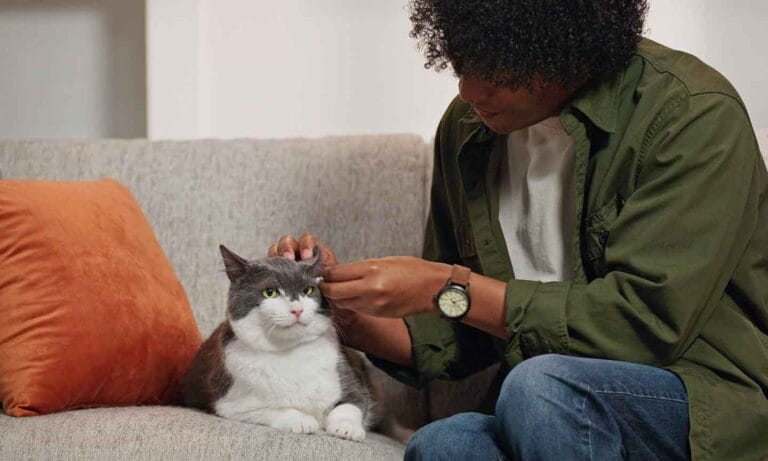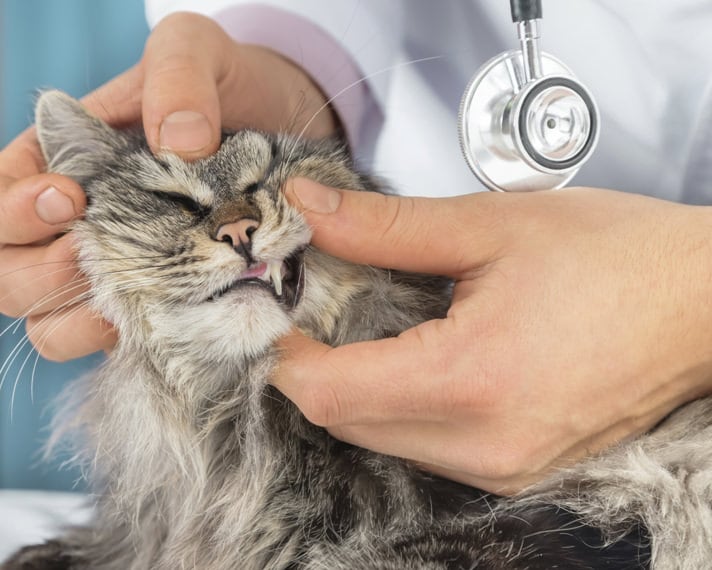If your cat won’t stop scratching, you might immediately suspect fleas. While it’s true that these little buggers are one of the most common reasons for an itchy cat, there are several other possible causes of itching—medically referred to as pruritus.
To help you narrow it down, we talked to three vet experts about why your cat might be scratching so much and what you can do about it.
Have an Itchy Cat?
Click to jump to each section.
Why Is My Cat Scratching So Much?
Hypersensitivities/Allergies
Allergies are one of the most likely triggers for itchy skin, according to Dr. Leslie Sinn, DVM, CPDT-KA, ACVB, founder of Behavior Solutions in Ashburn, Virginia. These can be airborne/environmental allergies like pollen, food allergies or contact allergies.
Environmental Allergies
An allergy to an airborne substance, like pollen or dust mites, is called atopy, and this type of reaction is often referred to as atopic dermatitis. It can develop at any age and in any breed.
In simple terms, atopic dermatitis is a result of your cat’s immune system going haywire. An environmental allergen triggers a response, which results in skin problems and itching. Atopic dermatitis can be seasonal or chronic, with no obvious change in symptoms throughout the year.
Food Allergies
A food allergy can manifest in a variety of ways, but itching around the head, neck, ears and face is a classic pattern. Because a food allergy is systemic and can affect your cat’s digestive system, you may also notice other signs, such as:
- Diarrhea
- Vomiting
- Straining to go to the bathroom
- Rashes or sores
- Discharge from the eyes and/or nose
- Sneezing or wheezing
- Coughing
Beef, fish, chicken and dairy are the most common food allergies in cats, and a cat has to be exposed to the allergen at least once to develop an allergy to it.
Contact Allergies
Contact allergies develop when your cat touches or rubs against something they’re allergic to. Typically, these reactions are localized to the spot where the contact occurs. Flea collars, shampoos, topicals and certain types of bedding can cause contact allergies.
Flea (or Other) Infestations
Itchiness and nonstop scratching are telltale signs of a flea infestation.
When a flea bites your cat, flea saliva gets into your cat’s skin. This can trigger an allergic reaction that results in extreme itchiness—a condition called flea allergy dermatitis (FAD). In extra sensitive cats, just one or two flea bites can be enough to cause major discomfort.
Dr. Sinn says cat owners often rule out a flea infestation because they don’t see bugs on their cat. But, she notes, fleas actually spend very little time on the animal; they typically bite and then jump off.
If you get to the point where you actually see bugs on your cat, you have a major infestation.
Even if you don’t see the fleas, they often leave behind flea eggs, which look like little white dots about the size of a grain of salt—or flea dirt, black specks that are a mixture of blood and flea waste. You often see signs of fleas if you brush your cat with a flea comb.
The most commonly affected areas where fleas affect cats are the head, neck, back, base of the tail, and hind legs. If you suspect fleas, look in these areas first to see if you can spot any bugs or insect bites. If you do, make an appointment with your vet to get flea treatment.
It’s also possible your cat has a lice infestation (officially known as pediculosis) or scabies mites, but Dr. Arnold Plotnick, DVM, cat expert and founder of Manhattan Cat Specialists in New York City, says this is relatively uncommon in otherwise healthy cats. If your cat has an immunosuppressive disorder, like feline immunodeficiency virus (FIV) infection, these might be more likely causes.
Infections
Ringworm, a fungal infection, is the most common infectious skin disease in cats, according to Dr. Plotnick. It can affect cats of any age, sex or breed, but young cats, senior cats and longhaired breeds are affected more often.
In addition to scratching and overgrooming, you may notice the following symptoms if your cat has ringworm:
- Crusty skin
- Circular areas of hair loss
- Inflamed or irritated skin
- Dandruff
- Changes in fur or skin color
Unlike some other causes of constant itching, ringworm is more easily diagnosed by doing a fungal culture.
Parasitic and bacterial infections of the skin are also possible infectious causes.
Medication Side Effects
In some cases, itching can be a medication side effect. Methimazole (brand name Tapazole or Felimazole), for example, may cause itching. Many cats develop hyperthyroidism as they get older, and methimazole is a common part of treatment, Dr. Plotnick says.
Typically, if the medication causes itching, it will mostly be concentrated around the head and face.
Stress or Boredom
Excessive scratching doesn’t always have a physical cause. If everything checks out with your cat’s health, this behavior may point to stress, anxiety or boredom. More often, you’ll see overgrooming (i.e., excessive licking); and stressed or bored cats may chew or scratch more than relaxed, content cats.
This is more likely in indoor cats because they don’t get as much stimulation as outdoor kitties.
When To Go to the Veterinarian about Cat Scratching
When your cat excessively scratches for long periods of time, their skin can become damaged and even infected. Consult a veterinarian if your cat is scratching for more than three consecutive days.
If the scratching is accompanied by other signs like visible fleas, take them to a vet as soon as you notice something is off.
How Vets Diagnose the Cause of an Itchy Cat
Diagnosing the cause of your cat's itching typically begins with a thorough physical examination, after which your vet may recommend additional tests such as skin scrapings, blood tests or allergy testing to pinpoint the underlying cause.
Dr. Plotnick says it’s best to visit a veterinary dermatologist if you suspect atopy, or airborne allergies. The dermatologist will perform an intradermal skin test, injecting small amounts of allergens into the skin and charting the skin reaction.
Once they’ve found the cause, your vet will recommend a treatment plan based on the results of the testing.
Treatment for Cat Itchy Skin
If Itching is Caused By Allergies…
If allergies are the main issue, your vet may recommend antihistamines or steroids to soothe the itching and make your cat more comfortable, says Dr. Bradley Krohn, DVM, a veterinarian with mobile veterinary service The Vets, based in Portland, Oregon.
If the itching is caused by food allergies, your cat will likely have to make dietary changes. The exact changes depend on what your cat is allergic to, but your vet may recommend a hypoallergenic cat food or a novel protein diet as a good place to start while you narrow down the right formula for your cat’s needs.
Dr. Sinn says hypoallergenic food should come from a vet’s prescription, if possible. While there are some hypoallergenic food options available without a prescription, cross contamination can be a major issue if the food manufacturer isn’t diligent about sterilizing equipment or keeping proteins separate.
An oral Cyclosporine solution may be recommended for cats who have chronic atopic dermatitis. Cyclosporine is an immunosuppressant that calms immune system overreactivity to reduce your cat’s itchiness and make them more comfortable. You will need a prescription for this one, as well as dosing recommendations from your vet.
If Itching Is Caused By Infections or Infestations…
Infections and infestations will be treated with medication.
Parasitic infestations will often require anti-parasitic medications, while bacterial skin infections may need to be treated with antibiotics. Ringworm is treated with an antifungal.
If Itching Is Caused By Fleas…
If fleas are the culprit, the first step will be to use a fast-acting oral flea treatment, like Capstar, to kill all the fleas. From there, your vet will likely recommend a preventative to make a recurrence less likely.
If environmental reactions or seasonal allergies are uncovered, your vet may recommend an injectable anti-allergy medication to control the itching and related symptoms.
No matter the cause, it’s crucial to follow your vet's guidance regarding medications and treatment for best results.
How Can I Soothe My Cat's Itchy Skin?
It’s always best to talk to your veterinarian about the itch-relief products you can use on your cat, but here are some general recommendations.
Regular Grooming
Brushing your cat can help remove irritants and reduce itching. It also removes dead hair and debris. Dr. Sinn says brushing is a good way to keep tabs on your cat’s coat and body condition so you always have an idea of what’s going on.
A warm bath
If your cat will allow it, give them a warm bath with a hypoallergenic or medicated shampoo. The warm water can help soothe the skin, while the shampoo can wash away potential allergens that may be the cause of itching.
Dr. Sinn recommends bathing your cat with a humidifying shampoo that contains a soothing ingredient, like aloe. She says this calms the skin, removes any crust and debris and can hopefully make the cat a little more comfortable.
Avoid perfumed shampoos or anything your cat can ingest that may be toxic. In other words, get a fragrance-free shampoo that’s effectively tested for safety on cats. Try the Earthbath Oatmeal and Aloe Shampoo—or if your cat won’t tolerate water, the Vet's Best Waterless Cat Bath.
Topical shampoos and creams
These contain active ingredients that can reduce inflammation and soothe the skin. Make sure you’re using shampoos or creams that are proven safe for cats.
Some options include the Veterinary Formula Clinical Care Itch Relief Spray and/or the topical Ventinque Labs Dermabliss Hydrocortisone, which are both cost-effective options that can provide some relief. Both products contain hydrocortisone, a steroid cream widely known for countering itchiness and reducing rashes, Dr. Krohn says.
Vacuum often
If your cat is allergic to dust mites or something environmental, vacuuming dust and dander can help decrease exposure.
Supplement with fatty acids
An omega-3 fatty acid supplement, like Vetoquinol Triglyceride OMEGA, can act as a low-level anti-inflammatory agent that reduces discomfort and itching.
Flea prevention
This won’t provide immediate relief, but protecting your cats from fleas and maintaining a clean, flea-free environment at home is essential to minimizing additional irritants.
To catch an infestation early, brush cats regularly with a flea comb.
More about cat scratching:
Share:



















